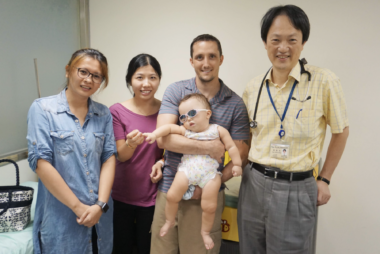Memories of a dark Christmas Eve on a park bench at night
How we succumbed to despair just hours before a life-changing diagnosis

Judy, my wife, and I sat slumped on a bench in a random park that we’d stumbled upon as we walked the cold streets of Taiwan on the night of Christmas Eve 2018. Somehow, we thought a bottle of vodka and juice would help to cool the burning we felt inside. Alone, we drank with only the stale white fluorescent light of the nearby convenience store illuminating our depressing date.
Judy and I had traveled to Taiwan from Singapore on a hunch. A week before Christmas, Judy’s older brother had found a random Facebook post about a child there with symptoms similar to those we’d seen in our daughter, Rylae-Ann. For eight months, we’d subjected our daughter to tests and scans. Everything had come back inconclusive or ended up being a misdiagnosis.
The Facebook post was our first real clue.
The child in the post had a rare neurotransmitter disorder known as aromatic l-amino acid decarboxylase (AADC) deficiency. At the time, it seemed unlikely that this ultrarare disease was the cause of our daughter’s inability to thrive, but the highest incidence rate was in Taiwan — where Judy’s family is from.
After reading the post, I went online and researched all I could about the disease. There was some information about a clinical trial in Taiwan, but no indication if there were more trials or if the drug were available. All I knew was that we needed to meet Professor Wuh-Liang Hwu, the doctor who was the primary researcher. Fortunately, Judy’s younger brother lived in Taiwan, and he secured us an appointment with Hwu on Christmas Day.
Christmas Eve
Our family landed in Taiwan on Christmas Eve and stayed at Judy’s aunt’s house. Judy’s mom was also there to help us. We barely left Rylae-Ann alone because we feared she’d choke. The day before the appointment, Judy and I were filled with anxiety.
Deep inside, I knew that AADC deficiency was the mystery disease that affected our daughter, but I kept my instincts to myself. I wanted Judy to have a few more days of hope while we waited for the appointment that would hopefully bring us some answers. Both of us knew by that point that if Rylae-Ann did have this disease, we could expect a short life, constant care, and no cure.
Judy’s mom and aunt forced us outside while they watched over Rylae-Ann because they were tired of us pacing the apartment. That’s why we walked the streets with no place in mind, and why we came across that park and began to drink. It was by far the lowest point in our lives. Our daughter was striving to live, and there was nothing we could do to ease her pain. We had mounting medical bills to pay and new jobs that we could no longer commit to.
As we talked, we realized these facts. I promised Judy that we’d never have another Christmas like this one again. We chugged the remaining concoction and headed back to the apartment to rise in the morning and meet the professor.
The appointment

The infant Rylae-Ann and her family pose with Professor Hwu, farthest right, at their first meeting in December 2018. (Courtesy of Richard E. Poulin III)
Outside Hwu’s office, we all nervously waited. I remember Rylae-Ann was noticeably calm that day. Before we went in, a nurse came out and asked us questions about why we thought our daughter might have this rare disease. We meticulously explained our story.
The doctor called us in. He took Rylae-Ann and gave her a quick examination. As he worked, he asked us questions. At the end, he turned to us and said he was confident she had AADC deficiency. After all those tests, here was a doctor who could diagnose her disease by our story and a short observation.
Judy began crying. We had an answer, but also knew the facts. But then came the big question I’d been crafting. I explained what I’d learned from the research he’d published about the clinical trial, and then I asked about its status. Hwu seemed surprised that I knew this information, but he informed us that the published clinical trials were closed, and the drug was unavailable.
The light on the other side
There was, however, an open phase of a clinical trial, but it was only available to Taiwanese people. Judy immediately jumped in and proclaimed that Rylae-Ann was Taiwanese. A spot was available, and Rylae-Ann could have it if we could keep her alive and well. We were more than up for the challenge.
Almost a year later, Rylae-Ann received gene therapy on Nov. 13, 2019, and has since made excellent progress. I also kept my promise and have made each Christmas since a wonderful family celebration. We also reflect on our blessings and how far we’ve come since that night on the park bench.
As you cross a dark path in life, know that there’s a light on the other side. The journey may not be what you envisioned, but it can still be full of meaning.
Note: AADC News is strictly a news and information website about the disease. It does not provide medical advice, diagnosis, or treatment. This content is not intended to be a substitute for professional medical advice, diagnosis, or treatment. Always seek the advice of your physician or other qualified health provider with any questions you may have regarding a medical condition. Never disregard professional medical advice or delay in seeking it because of something you have read on this website. The opinions expressed in this column are not those of AADC News or its parent company, Bionews, and are intended to spark discussion about issues pertaining to aromatic l-amino acid decarboxylase deficiency.








Comments